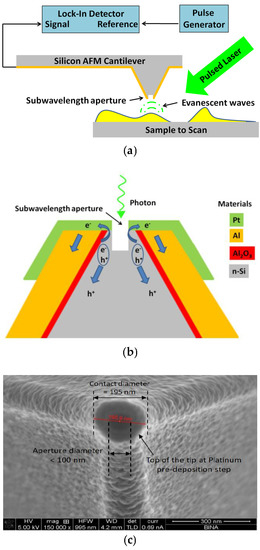Advanced Surface Probing Using a Dual-Mode NSOM–AFM Silicon-Based Photosensor
Abstract
:1. Introduction
1.1. Surface Scanning Background and Needs
1.2. AFM–NSOM Dual-Mode Concept
1.3. Multifunctionality and Energetic Efficiency
- Geometric efficiency:
- Angular efficiency:
- Fresnel efficiency:
2. Materials and Methods
2.1. Finite Elements Method (FEM)
2.2. Simulations Results of the Detector Structure
3. Results
3.1. Six-Step Quick Process Flow Overview
3.2. Consecutive Focus Ion Beam (FIB) Steps
3.3. AFM Scan Functionality Check
3.4. AFM Grating Check
4. Discussion
4.1. AFM Conserved Functionality of the Processed Tip
4.2. NSOM Working Modes vs. AFM–NSOM Dual Mode
- The transmission mode imaging, in which the sample is illuminated through the probe, and the light passing through the sample is collected and detected;
- The reflection mode imaging, in which the sample is illuminated through the probe, and the light reflected from the sample surface is collected and detected;
- The collection mode imaging, in which the sample is illuminated with a macroscopic light source from the top or bottom, and the probe is used to collect the light from the sample’s surface, which is also our mode of operation in dual-mode;
- And the illumination–collection mode imaging, in which the probe is used for both the illumination of the sample and for the collection of the reflected signal.
4.3. NSOM–AFM Dual-Mode of Work
5. Conclusions
6. Patents
Author Contributions
Funding
Acknowledgments
Conflicts of Interest
References
- Betzig, E.; Lewis, A.; Harootunian, A.; Isaacson, M.; Kratschmer, E. Near-field Scanning Optical Microscopy (NSOM), Development and Biophysical Applications. Biophys. J. 1986, 49, 269–279. [Google Scholar] [CrossRef] [Green Version]
- Pohl, D.W.; Denk, W.; Lanz, M. Optical stethoscopy: Image recording with resolution lamda/20. Appl. Phys. Lett. 1984, 44, 651–653. [Google Scholar] [CrossRef]
- Grabar, K.C.; Brown, K.R.; Keating, C.D.; Stranick, S.J.; Tang, S.L.; Natan, M.J. Nanoscale Characterization of Gold Colloid Monolayers: A Comparison of Four Techniques. Anal. Chem. 1997, 69, 471–477. [Google Scholar] [CrossRef]
- Dutta, A.K.; Vanoppen, P.; Jeuris, K.; Grim, P.C.M.; Pevenage, D.; Salesse, C.; De Schryver, F.C. Spectroscopic, AFM, and NSOM Studies of 3D Crystallites in Mixed Langmuir-Blodgett Films of N,N′-Bis (2,6-dimethylphenyl)-3,4,9,10-perylenetetracarboxylic Diimide and Stearic Acid. Langmuir 1999, 15, 607–612. [Google Scholar] [CrossRef]
- Kerimo, J.; Adams, D.M.; Barbara, P.F.; Kaschak, D.M.; Mallouk, T.E. NSOM Investigations of the Spectroscopy and Morphology of Self-Assembled Multilayered Thin Films. J. Phys. Chem. B 1998, 102, 9451–9460. [Google Scholar] [CrossRef] [Green Version]
- Lowman, G.M.; Daoud, N.; Case, R.M.; Carson, P.J.; Buratto, S.K. Local Energy Transfer in Self-Assembled Polyelectrolyte Thin Films Probed by Near-Field Optics. Nano Lett. 2001, 1, 677–682. [Google Scholar] [CrossRef]
- Jiang, R.H.; Chen, C.; Lin, D.Z.; Chou, H.C.; Chu, J.Y.; Yen, T.J. Near-Field Plasmonic Probe with Super Resolution and High Throughput and Signal-to-Noise Ratio. Nano Lett. 2018, 18, 881–885. [Google Scholar] [CrossRef]
- Ozcan, A.; Cubukcu, E.; Bilenca, A.; Crozier, K.B.; Bouma, B.E.; Capasso, F.; Tearney, G.J. Differential Near-Field Scanning Optical Microscopy. Nano Lett. 2006, 6, 2609–2616. [Google Scholar] [CrossRef]
- Sonnefraud, Y.; Chevalier, N.; Motte, J.F.; Huant, S.; Reiss, P.; Bleuse, J.; Chandezon, F.; Burnett, M.T.; Ding, W.; Maier, S.A. Near-field optical imaging with a CdSe single nanocrystal-based active tip. Opt. Express 2006, 14, 10596–10602. [Google Scholar] [CrossRef] [Green Version]
- Cuche, A.; Drezet, A.; Sonnefraud, Y.; Faklaris, O.; Treussart, F.; Roch, J.F.; Huant, S. Near-field optical microscopy with a nanodiamond-based single-photon tip. Opt. Express 2009, 17, 19969–19980. [Google Scholar] [CrossRef] [Green Version]
- Rotenberg, N.; Kuipers, L. Mapping nanoscale light fields. Nat. Photonics 2014, 8, 919–926. [Google Scholar] [CrossRef]
- Fact.MR. Scanning Probe Microscopes Market Forecast, Trend Analysis & Competition Tracking-Global Market Insights 2017 to 2026. Fact.MR Published Report. Available online: https://www.factmr.com/report/356/scanning-probe-microscopes-market (accessed on 15 November 2019).
- Nanonics Ltd. Atomic Force Microscopy Market Analysis 2018; Internal Study; 2018. Available online: https://www.nanonics.co.il/ (accessed on 15 November 2019).
- Harris, C.M. The Saga of AFM, A journey into a hot analytical market. Anal. Chem. 2001, 73, 627–635. [Google Scholar]
- Harris, C.M. Shedding light on NSOM. Anal. Chem. 2003, 75, 223–228. [Google Scholar] [CrossRef] [Green Version]
- Lu, F.; Jin, M.; Belkin, M.A. Tip-enhanced infrared nanospectroscopy via molecular expansion force detection. Nat. Photonics 2014, 8, 307–312. [Google Scholar] [CrossRef]
- Stern, L.; Desiatov, B.; Goykhman, I.; Lerman, G.M.; Levy, U. Near field phase mapping exploiting intrinsic oscillations of aperture NSOM probe. Opt. Express 2011, 19, 12014–12020. [Google Scholar] [CrossRef]
- Arora, S.; Arora, S.A.; George, P.J. Design of Mems Based Microcantilever Using Comsol Multiphysics. Int. J. Appl. Eng. Res. 2012, 7, 1582–1584. [Google Scholar]
- Zhao, Y.; An, K.H.; Chen, S.; O’Connor, B.; Pipe, K.P.; Shtein, M. Localized Current Injection and Submicron Organic Light-Emitting Device on a Pyramidal Atomic Force Microscopy Tip. Nano Lett. 2007, 7, 3645–3649. [Google Scholar] [CrossRef]
- An, K.H.; O’Connor, B.; Pipe, K.P.; Zhao, Y.; Shtein, M. Scanning optical probe microscopy with submicrometer resolution using an organic photodetector. Appl. Phys. Lett. 2008, 93, 033311-1. [Google Scholar] [CrossRef]
- Menon, P.; Zhou, H.; Casey, B.; Donaldson, L.; Smithlus, W.; Weaver, J.M.R. Cantilever based SNOM Probes with Structured Apertures. AIP Conf. Proc. 2003, 696, 242. [Google Scholar]
- Schürmann, G.; Noell, W.; Staufer, U.; De Rooij, N.F. Microfabrication of a combined AFM-SNOM Sensor. Ultramicroscopy 2000, 82, 33–38. [Google Scholar] [CrossRef]
- Wiesendanger, R. Scanning Probe Microscopy: Analytical Methods; Springer: Berlin, Germany, 1998. [Google Scholar]
- Comsol Multi-Physics Software Package. Available online: https://www.comsol.com/ (accessed on 15 November 2019).
- Karsenty, A.; Mandelbaum, Y. Computer Algebra Challenges in Nanotechnology: Accurate Modeling of nanoscale electro-optic devices using Finite Elements Method. Math. Comput. Sci. 2019, 13, 117–130. [Google Scholar] [CrossRef]
- Karsenty, A.; Mandelbaum, Y. Computer algebra in nanotechnology: Modeling of Nano Electro-Optic Devices using Finite Element Method (FEM). In Proceedings of the ACA 2017 23rd Conference on Applications of Computer Algebra, Session 6: Computer Algebra for Applied Physics 2017, Jerusalem, Israel, 17–21 July 2017; p. 138. [Google Scholar]
- Karelits, M.; Mandelbaum, Y.; Chelly, A.; Karsenty, A. Electro-Optical Study of Nanoscale Al-Si Truncated Conical Photodetector with Subwavelength Aperture. J. Nanophotonics 2017, 11, 046021-1. [Google Scholar] [CrossRef] [Green Version]
- Bruker AFM Probes. Available online: https://www.brukerafmprobes.com/p-3897-fesp-v2.aspx (accessed on 15 November 2019).
- NT-MDT Spectrum Instruments. Available online: http://www.ntmdt-tips.com/products/view/tgt1 (accessed on 15 November 2019).
- Chiou, Y.K.; Chang, J.M.; Chen, Y.C.; Tseng, F.G.; Wang, P.C. Multi Tips Atomic Force Microscopy for Dynamic Nano-movement Detection. In Proceedings of the IEEE Transducers Conference 2015, Anchorage, AK, USA, 21–25 June 2015; pp. 1413–1416. [Google Scholar]
- Chen, Y.; Cai, J.; Liu, M.; Zeng, G.; Feng, Q.; Chen, Z. Research on Double-Probe, Double and Triple-Tip Effects during Atomic Force Microscopy Scanning. Scanning 2004, 26, 155–161. [Google Scholar] [CrossRef] [Green Version]
- Bobrinetskii, I.I.; Nevolin, V.K.; Tsarik, K.A.; Chudinov, A.A. A Distribution of Ga+ Ions in a Silicon Substrate for Nano_Dimensional Masking. Russ. Microelectron. 2014, 43, 15–20. [Google Scholar] [CrossRef]
- Novotny, L.; Hecht, B. Principles of Nano-Photonics; Cambridge University Press: Cambridge, UK, 2006. [Google Scholar]
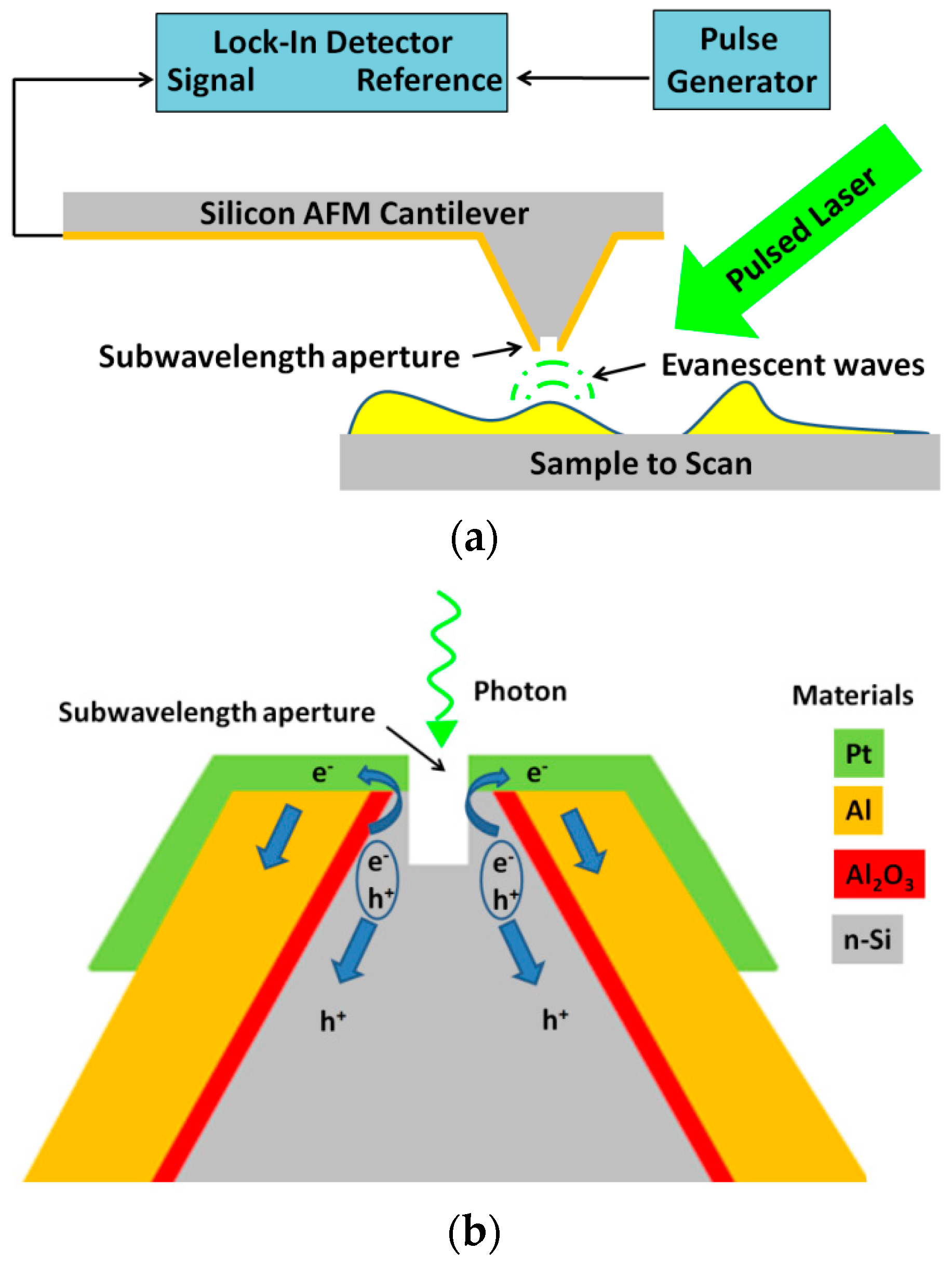




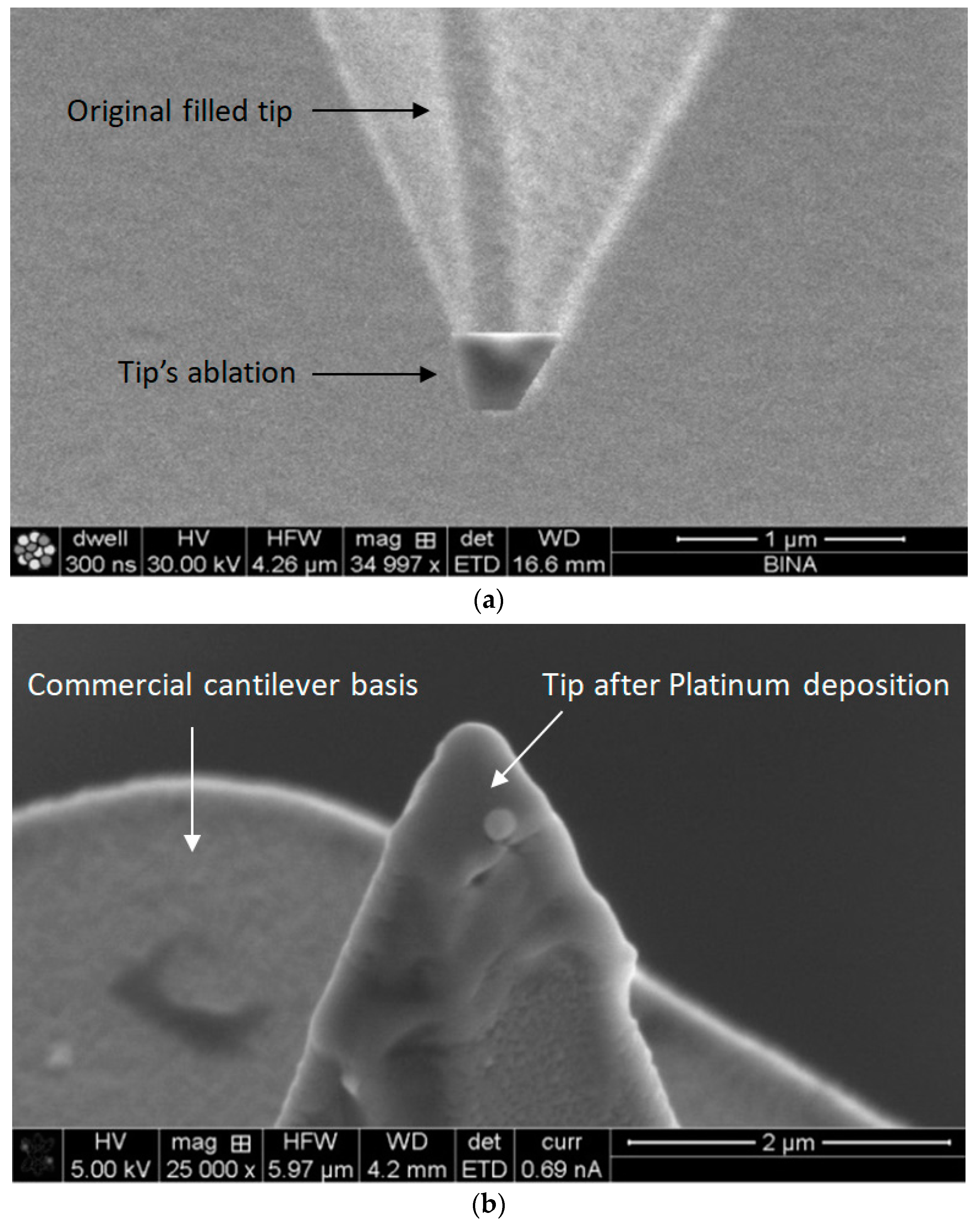
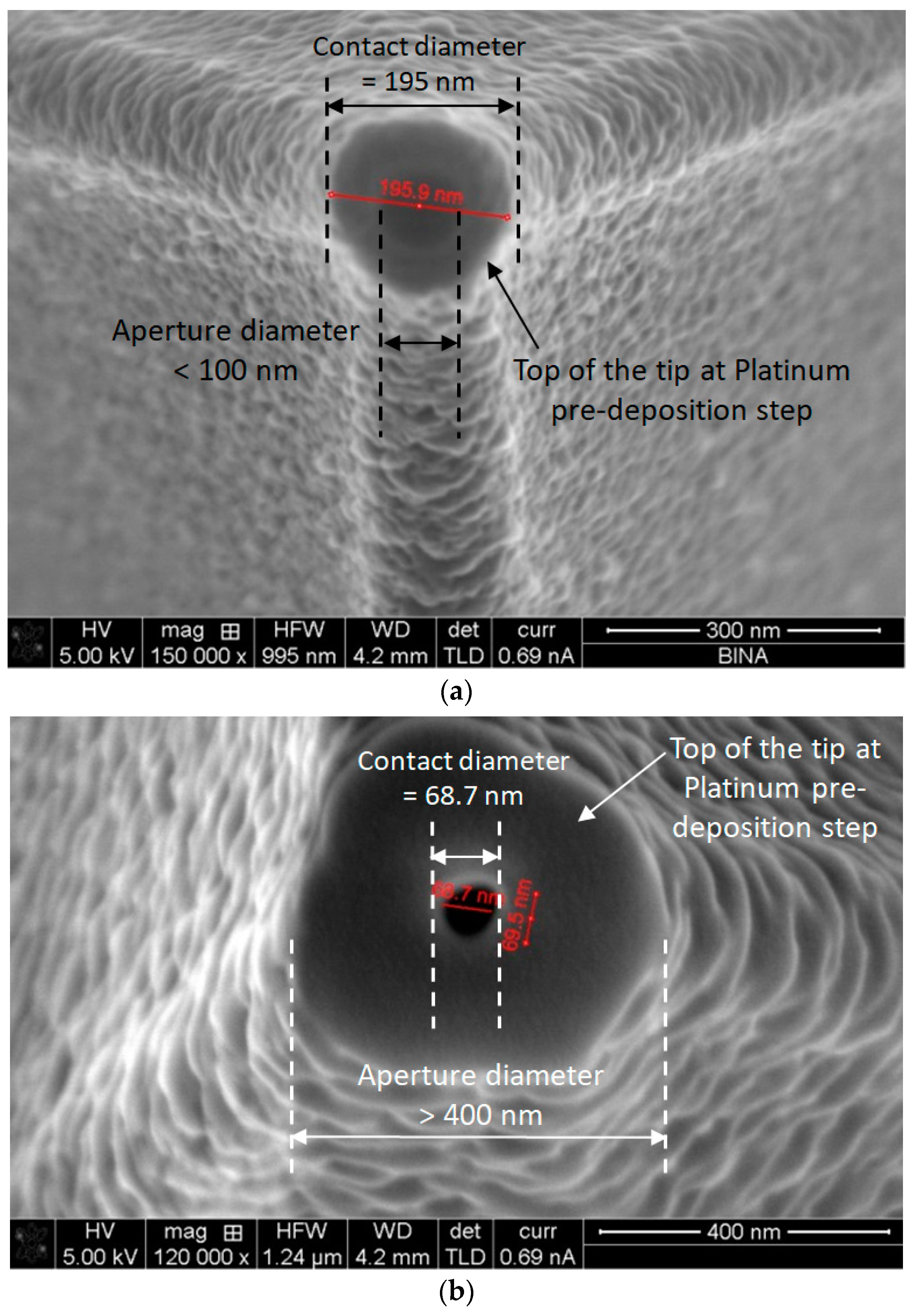









| Number and Name | Main Parameters and Legend | Process Schematics |
|---|---|---|
| Commercial Si-based AFM tips preparation | Type: n + Doping: As < 1017 cm−3 |  |
| Atomic Layer Deposition | Layer: Al2O3 (red color) Thickness: 50 nm Function: Insulator |  |
| Sputtering deposition of reflective and conductive layer | Layer: Aluminum (dark gray) Thickness: 200 nm Function: Top contact (Anode) | 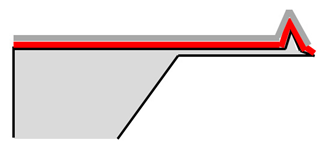 |
| FIB ablation of the tip | Initial Si aperture diameter: 100 nm | 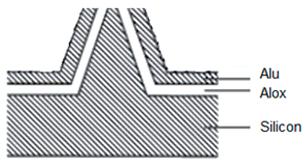 |
| In situ FIB deposition | Layer: Platinum Thickness: 200 nm Function: Schottky contact to Si | 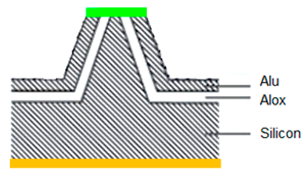 |
| In situ FIB drilling | Detector final aperture diameter: <100 nm Depth: >200 nm | 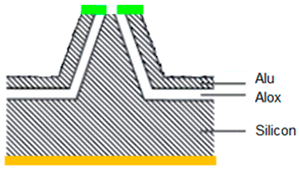 |
© 2019 by the authors. Licensee MDPI, Basel, Switzerland. This article is an open access article distributed under the terms and conditions of the Creative Commons Attribution (CC BY) license (http://creativecommons.org/licenses/by/4.0/).
Share and Cite
Karelits, M.; Lozitsky, E.; Chelly, A.; Zalevsky, Z.; Karsenty, A. Advanced Surface Probing Using a Dual-Mode NSOM–AFM Silicon-Based Photosensor. Nanomaterials 2019, 9, 1792. https://doi.org/10.3390/nano9121792
Karelits M, Lozitsky E, Chelly A, Zalevsky Z, Karsenty A. Advanced Surface Probing Using a Dual-Mode NSOM–AFM Silicon-Based Photosensor. Nanomaterials. 2019; 9(12):1792. https://doi.org/10.3390/nano9121792
Chicago/Turabian StyleKarelits, Matityahu, Emanuel Lozitsky, Avraham Chelly, Zeev Zalevsky, and Avi Karsenty. 2019. "Advanced Surface Probing Using a Dual-Mode NSOM–AFM Silicon-Based Photosensor" Nanomaterials 9, no. 12: 1792. https://doi.org/10.3390/nano9121792
APA StyleKarelits, M., Lozitsky, E., Chelly, A., Zalevsky, Z., & Karsenty, A. (2019). Advanced Surface Probing Using a Dual-Mode NSOM–AFM Silicon-Based Photosensor. Nanomaterials, 9(12), 1792. https://doi.org/10.3390/nano9121792






